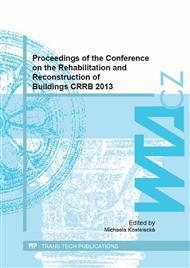[1]
J. M. Branco, M. Piazza, P. J. S. Cruz, Structural analysis of two king-post timber trusses: Non-destructive evaluation and load-carrying tests, Construction and Building Materials, 24 (2010) 371-383.
DOI: 10.1016/j.conbuildmat.2009.08.025
Google Scholar
[2]
M. Chudnoff, W. E. Eslyn, D. B. McKeever, Decay in mine timbers: Part III. Species – independent stress grading, Forest Product Journal, 34 (1984) 43-50.
Google Scholar
[3]
J. Daňková, T. Daněk, M. Vavro, The church of st. Catherine of Alexandria in Opava – Kateřinky, Zpravodaj WTA, 1 – 2 (2013) 20-24.
Google Scholar
[4]
P. Dietsch, H. Kreuzinger, Guideline on the assessment of timber structures: Summary, Engineering Structures, 33 (2011) 2983-2986.
DOI: 10.1016/j.engstruct.2011.02.027
Google Scholar
[5]
R. Görlacher, Non destructive testing of wood: An in-situ method for determination of density, Holz as Roh-und Werkstoff, 45 (1987) 273-278.
DOI: 10.1007/bf02608673
Google Scholar
[6]
C. P. Hansen, Application of the PILODYN in forest tree improvement, DFSC Series of Technical Notes TN55 (2000).
Google Scholar
[7]
P. Hoffmeyer, The pilodyn instrument as a nondestructive tester of the shock resistance of wood, 4th nondestructive testing of wood symposium: Proceedings (1978) 47-66.
Google Scholar
[8]
M. M. Micko, E. I. C. Wang, F. W. Taylor, et al., Determination of wood density in standing white spruce using pilodyn tester, The Forestry Chronicle, 58 (1982) 178-180.
DOI: 10.5558/tfc58178-4
Google Scholar
[9]
L. Palia, Structural failure analysis of timber floors and roofs in ancient buildings at Valencia (Spain), Proceedings of the 16th International Symposium of the IIWC, Florence, Venice and Vicenza (2007).
Google Scholar
[10]
M. Piazza, M. Raggio, NDT methodts for the assessment of structural timber: Report on the researches carried out at the University of Trento (Italy), RILEM Symposium on On Site Assessment of Concrete, Masonry and Timber Structures – SACoMaTiS, 2 (2008).
Google Scholar
[11]
J. R. Sprague, J. T. Talbert, J. B. Jett, et al., Utility of the Pilodyn in selection for nature wood specific gravity in loblolly pine, Forest Science, 27 (1983) 696-701.
Google Scholar


